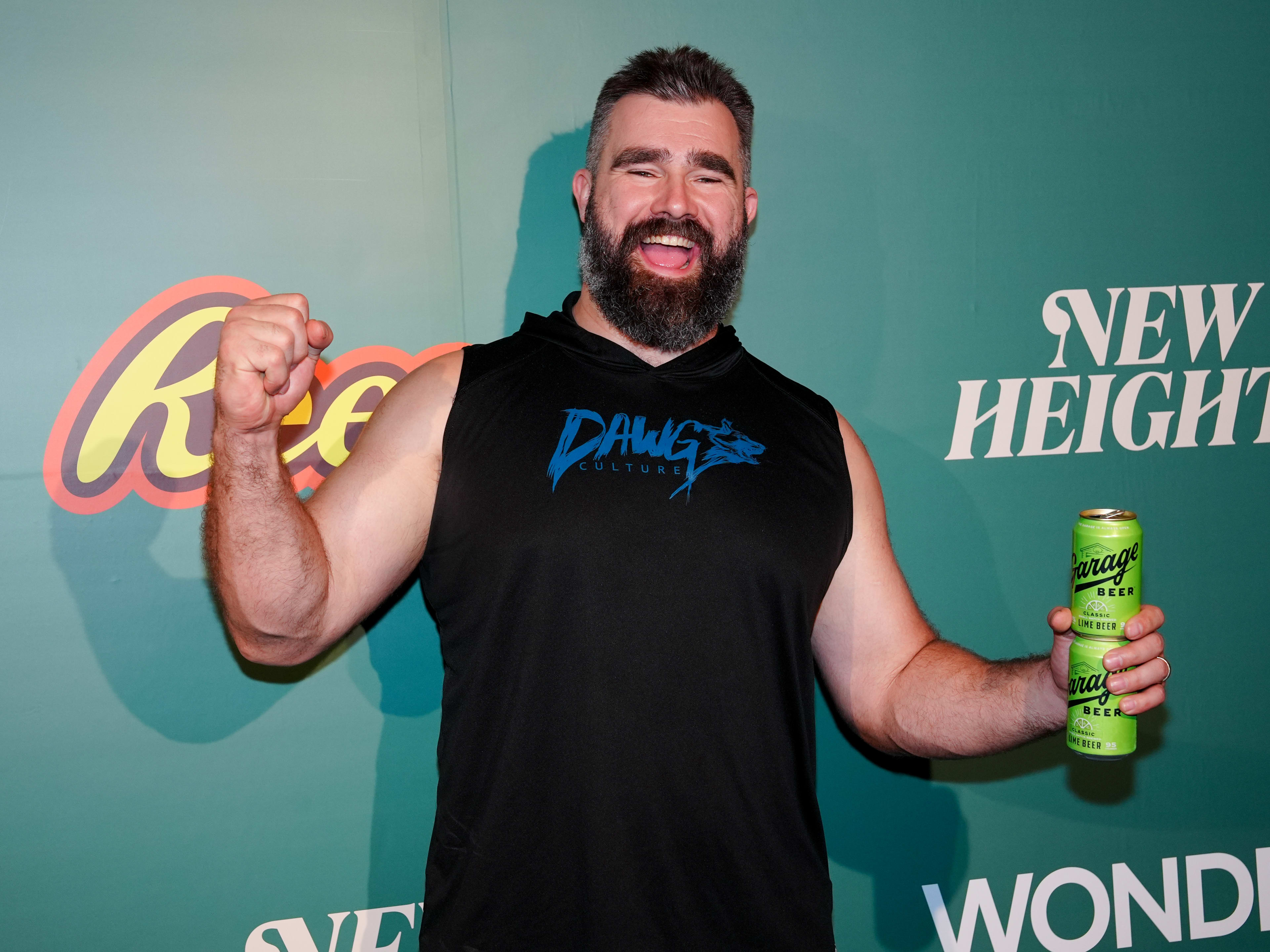You don’t expect to see a man who spent thirteen years wrestling 300-pound defensive linemen to walk into a room looking—well, almost light. Not slight, not fragile. Just lighter, leaner. And Jason Kelce knows it.
“I played my whole career at around 295,” he said, almost shrugging, almost daring you to ask the obvious. “Now? I’m down about 270. Some days 268 if I haven’t hit the beer.”
There it is. The grin. The honesty. The offhand reference to what every lineman dreams of after the NFL: freedom from the weight.

A Life at 295: The Burden of the Line
For over a decade, Jason Kelce carried the 295-pound frame of a professional center. It wasn’t optional; it was tactical. You don’t snap the ball, anchor a line, and block world-class athletes unless you’ve got mass. He called it “occupational weight.”
“I don’t think people realize,” he told his brother Travis on their podcast New Heights, “that carrying that weight is exhausting. You feel it when you wake up, you feel it when you try to run with your kids. It’s part of the job, but not natural.”
Natural. That word stuck. Because what Kelce looks like now—trimmer face, shoulders still broad but defined—is closer to natural than the oversized suit he wore on Sundays in Philly green.
Retirement, Then Transformation
The timeline is neat: March 2024, Jason Kelce retires. May 2025, he’s on a golf course in Pennsylvania, shirtless, 30 pounds gone, the crowd buzzing as if he’d scored another Super Bowl touchdown.
“I knew the weight would come off once I stopped stuffing my face for practice,” he laughed.
Reports confirm it: first 25 pounds, then edging to 30. Fans caught it in stages. A slimmer suit at the NFL Draft. A sleeveless gym photo where the arms looked more like a tight end than a center. By summer 2025, headlines were shouting it: Jason Kelce weight loss—nearly 30 pounds shed.
What Exactly Changed?
Not a secret cleanse. Not Ozempic. Not some Hollywood shortcut.
Kelce’s approach was almost boring, which made it oddly refreshing:
-
Diet: less volume, more balance. “You can’t eat like you’re burning 8,000 calories a day when you’re not practicing two hours in the heat.”
-
Workout: still lifting, still cardio. Push-ups, range-of-motion work, light runs. “I don’t need to max bench anymore. I just want to move.”
-
Goal weight: 250 pounds. “That’s the dream number. I haven’t seen 250 since college.”
The words land with a mix of nostalgia and determination. You can almost picture the number glowing back at him on the bathroom scale.
Why Fans Can’t Stop Talking About It
This isn’t just a man losing weight. It’s a cultural shift. Jason Kelce was the archetype of the NFL lineman—bearded, burly, everyman-hero. Seeing him slim down forces fans to confront what happens after the roar of the crowd fades.
One fan on Reddit wrote: “Dude looks ripped. Retirement looks good on him.” Another: “Crazy transformation. Almost didn’t recognize him.”
And yes, there’s the other side: Jason himself joked about the downside. “Honestly, weight loss is depressing sometimes. Pants don’t fit. I look at myself and think, ‘Who the hell is this guy?’”
It’s that mix—humor, honesty, and a little self-deprecation—that keeps people hooked.
The Symbolism of 30 Pounds
It’s more than a number. It’s a release from the years of carrying almost 300 pounds of steel and armor. It’s a father stepping into a backyard game of tag without gasping for air. It’s proof that even the men built like walls want, at some point, to feel human again.
And it isn’t lost on Jason that fans see it as inspiring. “If I can do it, if I can shed this weight after playing center, anyone can,” he said, half-serious, half-laughing.
Visualizing the Change
Picture it:
-
The bathroom scale blinking 295 → 270.
-
A refrigerator less stocked with beer and wings, more chicken and vegetables.
-
A set of dumbbells in the garage, sweat dripping on concrete, the echo of push-ups counted aloud.
The images matter because they make the abstract—weight loss—into something you can feel.
Jason Kelce Weight Loss as Inspiration Beyond Football
Jason Kelce’s story isn’t just about a lineman slimming down. It’s about transition. About moving from a life of performance and expectation into one of sustainability.
Fans who followed his career now follow his diet tips, his workouts, his reflections on New Heights. And why not? If Jason Kelce weight loss is possible, then so is anyone else’s.
What Comes Next?
The goal is 250 pounds. He’s not there yet. But he’s close.
And unlike the field, there’s no clock ticking down here. No defensive tackle pushing back. Just Jason Kelce, a scale, and the quiet discipline of a man who’s already proven enough on Sundays.
“I’m enjoying it,” he admitted. “Not being 295. Not having to keep that bulk. I feel lighter. I feel healthier. I feel like myself.”
That last line lingers. Himself. Because maybe that’s what this weight loss is all about—not just the body, but the identity underneath it.
Conclusion: The Weight of Letting Go
Weight loss stories are often framed as before-and-after. But for Jason Kelce, it’s less a transformation than a shedding. A letting go of the weight he carried for a city, for a team, for a career.
And if you catch him shirtless on a golf course this summer, arms roped with muscle, midsection leaner than it’s been in decades—you’ll see what fans see: not just a retired player, but a man who finally looks the way he feels.